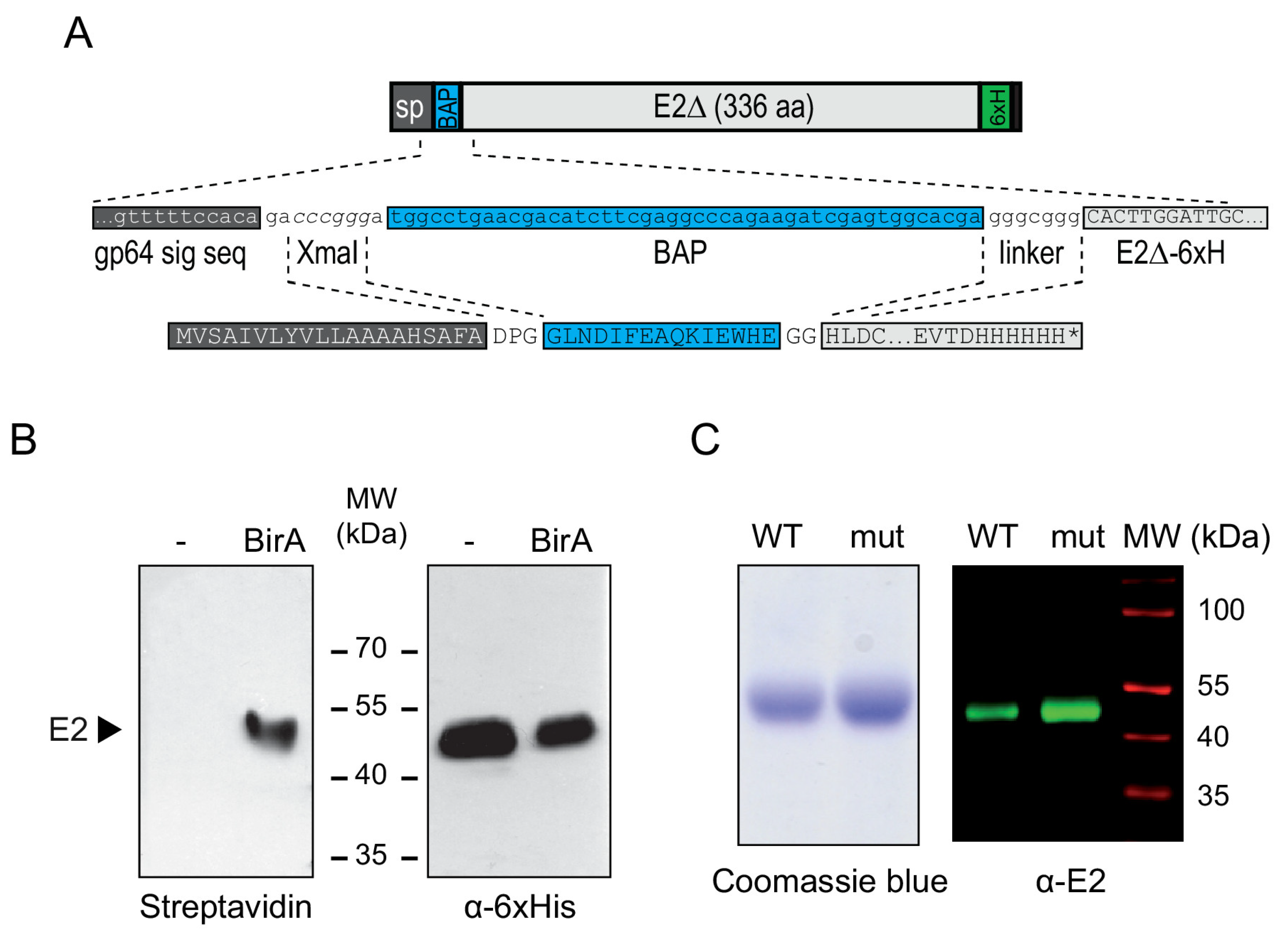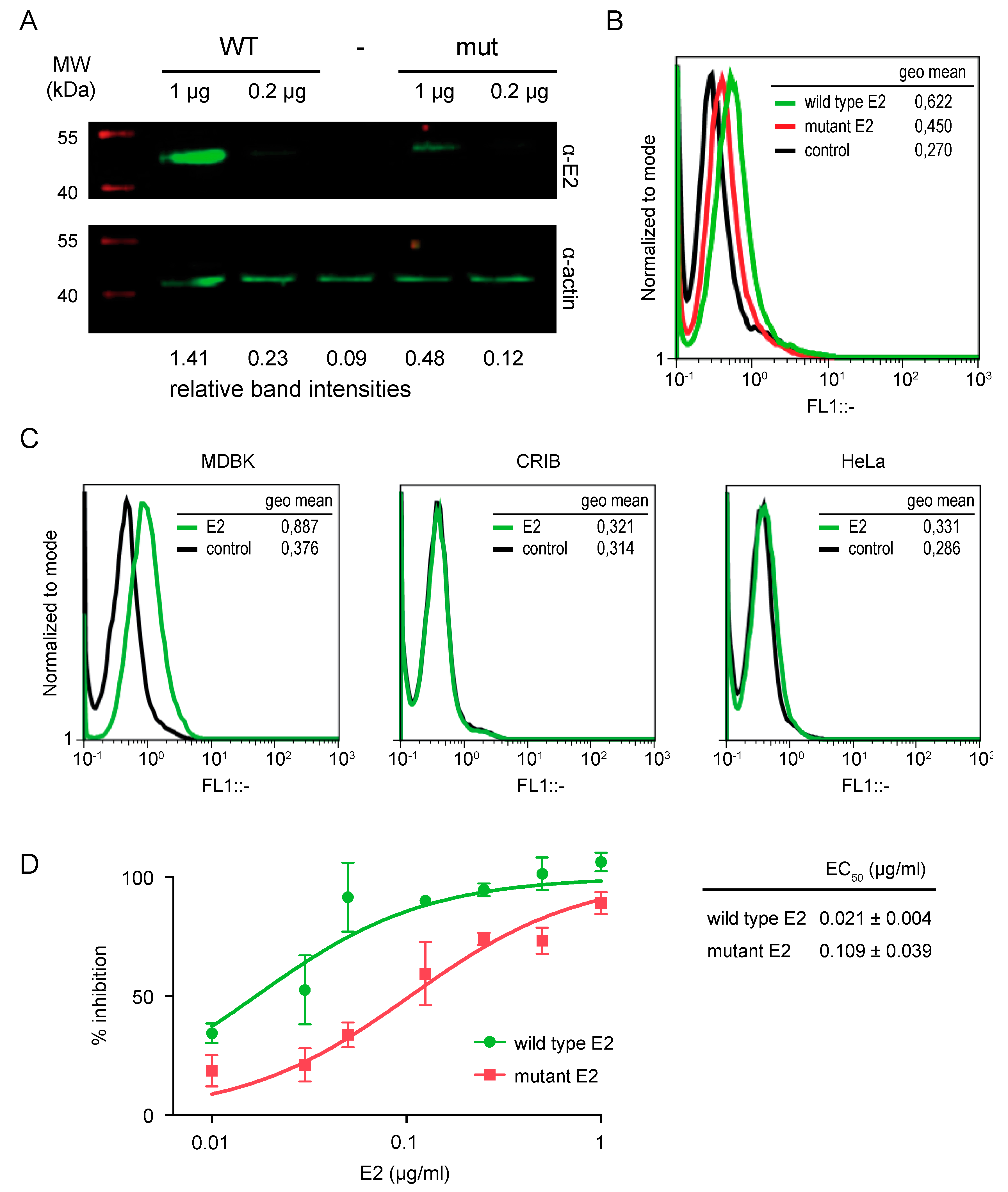A ?-Hairpin Motif in the Envelope Protein E2 Mediates Receptor Binding of Bovine Viral Diarrhea Virus
Abstract
:1. Introduction
2. Materials and Methods
2.1. Cells and Viruses
2.2. Virus Titration by qPCR
2.3. Construction of Recombinant ncpBVDV Carrying Mutations in E2
2.4. Recombinant E2 Expression and Purification
2.5. Fluorescence Microscopy
2.6. Binding Assays
2.6.1. E2-Binding Detected by Western Blot
2.6.2. E2-Binding Detected by Flow Cytometry
2.7. Cytopathic Effect Reduction Assay
2.8. Selection of Revertant Viruses
3. Results
3.1. Design of Mutations
3.2. Mutation of the β-Hairpin Motif Impairs Function of E2
3.3. The E2 β-Hairpin Is Critical for BVDV Infection
3.4. BVDV Infectivity Is Recovered after Reversion of N144A and T147A Mutations
4. Discussion
Author Contributions
Funding
Institutional Review Board Statement
Informed Consent Statement
Data Availability Statement
Acknowledgments
Conflicts of Interest
References
- Smith, D.B.; Meyers, G.; Bukh, J.; Gould, E.A.; Monath, T.; Scott Muerhoff, A.; Pletnev, A.; Rico-Hesse, R.; Stapleton, J.T.; Simmonds, P.; et al. Proposed Revision to the Taxonomy of the Genus Pestivirus, Family Flaviviridae. J. Gen. Virol. 2017, 98, 2106–2112. [Google Scholar] [CrossRef] [PubMed]
- Tautz, N.; Tews, B.A.; Meyers, G. The Molecular Biology of Pestiviruses. Adv. Virus Res. 2015, 93, 47–160. [Google Scholar] [CrossRef]
- Liang, D.; Sainz, I.F.; Ansari, I.H.; Gil, L.H.V.G.; Vassilev, V.; Donis, R.O. The Envelope Glycoprotein E2 Is a Determinant of Cell Culture Tropism in Ruminant Pestiviruses. J. Gen. Virol. 2003, 84, 1269–1274. [Google Scholar] [CrossRef] [PubMed]
- Chang, C.-Y.; Huang, C.-C.; Lin, Y.-J.; Deng, M.-C.; Chen, H.-C.; Tsai, C.-H.; Chang, W.-M.; Wang, F.-I. Antigenic Domains Analysis of Classical Swine Fever Virus E2 Glycoprotein by Mutagenesis and Conformation-Dependent Monoclonal Antibodies. Virus Res. 2010, 149, 183–189. [Google Scholar] [CrossRef]
- Chang, C.-Y.; Huang, C.-C.; Lin, Y.-J.; Deng, M.-C.; Tsai, C.-H.; Chang, W.-M.; Wang, F.-I. Identification of Antigen-Specific Residues on E2 Glycoprotein of Classical Swine Fever Virus. Virus Res. 2010, 152, 65–72. [Google Scholar] [CrossRef] [PubMed]
- Qi, Y.; Liu, L.C.; Zhang, B.Q.; Shen, Z.; Wang, J.; Chen, Y.H. Characterization of Antibody Responses against a Neutralizing Epitope on the Glycoprotein E2 of Classical Swine Fever Virus. Arch. Virol. 2008, 153, 1593–1598. [Google Scholar] [CrossRef]
- van Rijn, P.A. A Common Neutralizing Epitope on Envelope Glycoprotein E2 of Different Pestiviruses: Implications for Improvement of Vaccines and Diagnostics for Classical Swine Fever (CSF)? Vet. Microbiol. 2007, 125, 150–156. [Google Scholar] [CrossRef] [PubMed] [Green Version]
- Deregt, D.; Bolin, S.R.; van den Hurk, J.; Ridpath, J.F.; Gilbert, S.A. Mapping of a Type 1-Specific and a Type-Common Epitope on the E2 (Gp53) Protein of Bovine Viral Diarrhea Virus with Neutralization Escape Mutants. Virus Res. 1998, 53, 81–90. [Google Scholar] [CrossRef]
- Yu, M.; Wang, L.F.; Shiell, B.J.; Morrissy, C.J.; Westbury, H.A. Fine Mapping of a C-Terminal Linear Epitope Highly Conserved among the Major Envelope Glycoprotein E2 (Gp51 to Gp54) of Different Pestiviruses. Virology 1996, 222, 289–292. [Google Scholar] [CrossRef] [Green Version]
- Merwaiss, F.; Czibener, C.; Alvarez, D.E. Cell-to-Cell Transmission Is the Main Mechanism Supporting Bovine Viral Diarrhea Virus Spread in Cell Culture. J. Virol. 2018, 93. [Google Scholar] [CrossRef] [Green Version]
- Hulst, M.M.; Moormann, R.J. Inhibition of Pestivirus Infection in Cell Culture by Envelope Proteins E(Rns) and E2 of Classical Swine Fever Virus: E(Rns) and E2 Interact with Different Receptors. J. Gen. Virol. 1997, 78, 2779–2787. [Google Scholar] [CrossRef] [PubMed] [Green Version]
- Krey, T.; Himmelreich, A.; Heimann, M.; Menge, C.; Thiel, H.-J.; Maurer, K.; Rümenapf, T. Function of Bovine CD46 as a Cellular Receptor for Bovine Viral Diarrhea Virus Is Determined by Complement Control Protein 1. J. Virol. 2006, 80, 3912–3922. [Google Scholar] [CrossRef] [Green Version]
- Maurer, K.; Krey, T.; Moennig, V.; Thiel, H.-J.; Rümenapf, T. CD46 Is a Cellular Receptor for Bovine Viral Diarrhea Virus. J. Virol. 2004, 78, 1792–1799. [Google Scholar] [CrossRef] [Green Version]
- Szillat, K.P.; Koethe, S.; Wernike, K.; Höper, D.; Beer, M. A CRISPR/Cas9 Generated Bovine CD46-Knockout Cell Line—A Tool to Elucidate the Adaptability of Bovine Viral Diarrhea Viruses (BVDV). Viruses 2020, 12, 859. [Google Scholar] [CrossRef]
- Cagatay, G.N.; Antos, A.; Suckstorff, O.; Isken, O.; Tautz, N.; Becher, P.; Postel, A. Porcine Complement Regulatory Protein CD46 Is a Major Receptor for Atypical Porcine Pestivirus but Not for Classical Swine Fever Virus. J. Virol. 2021, 95. [Google Scholar] [CrossRef]
- El Omari, K.; Iourin, O.; Harlos, K.; Grimes, J.M.; Stuart, D.I. Structure of a Pestivirus Envelope Glycoprotein E2 Clarifies Its Role in Cell Entry. Cell Rep. 2013, 3, 30–35. [Google Scholar] [CrossRef] [PubMed] [Green Version]
- Li, Y.; Wang, J.; Kanai, R.; Modis, Y. Crystal Structure of Glycoprotein E2 from Bovine Viral Diarrhea Virus. Proc. Natl. Acad. Sci. USA 2013, 110, 6805–6810. [Google Scholar] [CrossRef] [Green Version]
- Risatti, G.R.; Holinka, L.G.; Carrillo, C.; Kutish, G.F.; Lu, Z.; Tulman, E.R.; Sainz, I.F.; Borca, M.V. Identification of a Novel Virulence Determinant within the E2 Structural Glycoprotein of Classical Swine Fever Virus. Virology 2006, 355, 94–101. [Google Scholar] [CrossRef] [Green Version]
- Borca, M.V.; Holinka, L.G.; Ramirez-Medina, E.; Risatti, G.R.; Vuono, E.A.; Berggren, K.A.; Gladue, D.P. Identification of Structural Glycoprotein E2 Domain Critical to Mediate Replication of Classical Swine Fever Virus in SK6 Cells. Virology 2019, 526, 38–44. [Google Scholar] [CrossRef] [PubMed]
- Li, X.; Wang, L.; Zhao, D.; Zhang, G.; Luo, J.; Deng, R.; Yang, Y. Identification of Host Cell Binding Peptide from an Overlapping Peptide Library for Inhibition of Classical Swine Fever Virus Infection. Virus Genes 2011, 43, 33–40. [Google Scholar] [CrossRef]
- Leifer, I.; Blome, S.; Blohm, U.; König, P.; Küster, H.; Lange, B.; Beer, M. Characterization of C-Strain “Riems” TAV-Epitope Escape Variants Obtained through Selective Antibody Pressure in Cell Culture. Vet. Res. 2012, 43, 33. [Google Scholar] [CrossRef] [Green Version]
- Mendez, E.; Ruggli, N.; Collett, M.S.; Rice, C.M. Infectious Bovine Viral Diarrhea Virus (Strain NADL) RNA from Stable CDNA Clones: A Cellular Insert Determines NS3 Production and Viral Cytopathogenicity. J. Virol. 1998, 72, 4737–4745. [Google Scholar] [CrossRef] [PubMed] [Green Version]
- Unger, T.; Jacobovitch, Y.; Dantes, A.; Bernheim, R.; Peleg, Y. Applications of the Restriction Free (RF) Cloning Procedure for Molecular Manipulations and Protein Expression. J. Struct. Biol. 2010, 172, 34–44. [Google Scholar] [CrossRef] [PubMed]
- Hopkins, R.F.; Esposito, D. A Rapid Method for Titrating Baculovirus Stocks Using the Sf-9 Easy Titer Cell Line. Biotechniques 2009, 47, 785–788. [Google Scholar] [CrossRef] [Green Version]
- Stapleford, K.A.; Lindenbach, B.D. Hepatitis C Virus NS2 Coordinates Virus Particle Assembly through Physical Interactions with the E1-E2 Glycoprotein and NS3-NS4A Enzyme Complexes. J. Virol. 2011, 85, 1706–1717. [Google Scholar] [CrossRef] [PubMed] [Green Version]
- Pascual, M.J.; Merwaiss, F.; Leal, E.; Quintana, M.E.; Capozzo, A.V.; Cavasotto, C.N.; Bollini, M.; Alvarez, D.E. Structure-Based Drug Design for Envelope Protein E2 Uncovers a New Class of Bovine Viral Diarrhea Inhibitors That Block Virus Entry. Antivir. Res. 2018, 149. [Google Scholar] [CrossRef] [PubMed] [Green Version]
- Simossis, V.A.; Heringa, J. PRALINE: A Multiple Sequence Alignment Toolbox That Integrates Homology-Extended and Secondary Structure Information. Nucleic Acids Res. 2005, 33, W289–W294. [Google Scholar] [CrossRef]
- Humphrey, W.; Dalke, A.; Schulten, K. VMD: Visual Molecular Dynamics. J. Mol. Graph. 1996, 14, 33–38. [Google Scholar] [CrossRef]
- Flores, E.F.; Donis, R.O. Isolation of a Mutant MDBK Cell Line Resistant to Bovine Viral Diarrhea Virus Infection Due to a Block in Viral Entry. Virology 1995, 208, 565–575. [Google Scholar] [CrossRef] [PubMed] [Green Version]
- Krey, T.; Moussay, E.; Thiel, H.-J.; Rümenapf, T. Role of the Low-Density Lipoprotein Receptor in Entry of Bovine Viral Diarrhea Virus. J. Virol. 2006, 80, 10862–10867. [Google Scholar] [CrossRef] [Green Version]
- Su, A.; Fu, Y.; Meens, J.; Yang, W.; Meng, F.; Herrler, G.; Becher, P. Infection of Polarized Bovine Respiratory Epithelial Cells by Bovine Viral Diarrhea Virus (BVDV). Virulence 2021, 12, 177–187. [Google Scholar] [CrossRef] [PubMed]
- Borca, M.V.; Vuono, E.A.; Ramirez-Medina, E.; Azzinaro, P.; Berggren, K.A.; Singer, M.; Rai, A.; Pruitt, S.; Silva, E.B.; Velazquez-Salinas, L.; et al. Structural Glycoprotein E2 of Classical Swine Fever Virus Interacts with Host Protein Dynactin Subunit 6 (DCTN6) during the Virus Infectious Cycle. J. Virol. 2019, 94, e01642-19. [Google Scholar] [CrossRef]
- Vuono, E.A.; Ramirez-Medina, E.; Azzinaro, P.; Berggren, K.A.; Rai, A.; Pruitt, S.; Silva, E.; Velazquez-Salinas, L.; Borca, M.V.; Gladue, D.P. SERTA Domain Containing Protein 1 (SERTAD1) Interacts with Classical Swine Fever Virus Structural Glycoprotein E2, Which Is Involved in Virus Virulence in Swine. Viruses 2020, 12, 421. [Google Scholar] [CrossRef] [PubMed] [Green Version]
- Vuono, E.A.; Ramirez-Medina, E.; Berggren, K.; Rai, A.; Pruitt, S.; Silva, E.; Velazquez-Salinas, L.; Gladue, D.P.; Borca, M.V. Swine Host Protein Coiled-Coil Domain-Containing 115 (CCDC115) Interacts with Classical Swine Fever Virus Structural Glycoprotein E2 during Virus Replication. Viruses 2020, 12, 388. [Google Scholar] [CrossRef] [PubMed] [Green Version]





Publisher’s Note: MDPI stays neutral with regard to jurisdictional claims in published maps and institutional affiliations. |
© 2021 by the authors. Licensee MDPI, Basel, Switzerland. This article is an open access article distributed under the terms and conditions of the Creative Commons Attribution (CC BY) license (https://creativecommons.org/licenses/by/4.0/).
Share and Cite
Merwaiss, F.; Pascual, M.J.; Pomilio, M.T.; Lopez, M.G.; Taboga, O.A.; Alvarez, D.E. A ?-Hairpin Motif in the Envelope Protein E2 Mediates Receptor Binding of Bovine Viral Diarrhea Virus. Viruses 2021, 13, 1157. https://doi.org/10.3390/v13061157
Merwaiss F, Pascual MJ, Pomilio MT, Lopez MG, Taboga OA, Alvarez DE. A ?-Hairpin Motif in the Envelope Protein E2 Mediates Receptor Binding of Bovine Viral Diarrhea Virus. Viruses. 2021; 13(6):1157. https://doi.org/10.3390/v13061157
Chicago/Turabian StyleMerwaiss, Fernando, María José Pascual, María Trinidad Pomilio, María Gabriela Lopez, Oscar A. Taboga, and Diego E. Alvarez. 2021. "A ?-Hairpin Motif in the Envelope Protein E2 Mediates Receptor Binding of Bovine Viral Diarrhea Virus" Viruses 13, no. 6: 1157. https://doi.org/10.3390/v13061157
APA StyleMerwaiss, F., Pascual, M. J., Pomilio, M. T., Lopez, M. G., Taboga, O. A., & Alvarez, D. E. (2021). A ?-Hairpin Motif in the Envelope Protein E2 Mediates Receptor Binding of Bovine Viral Diarrhea Virus. Viruses, 13(6), 1157. https://doi.org/10.3390/v13061157






